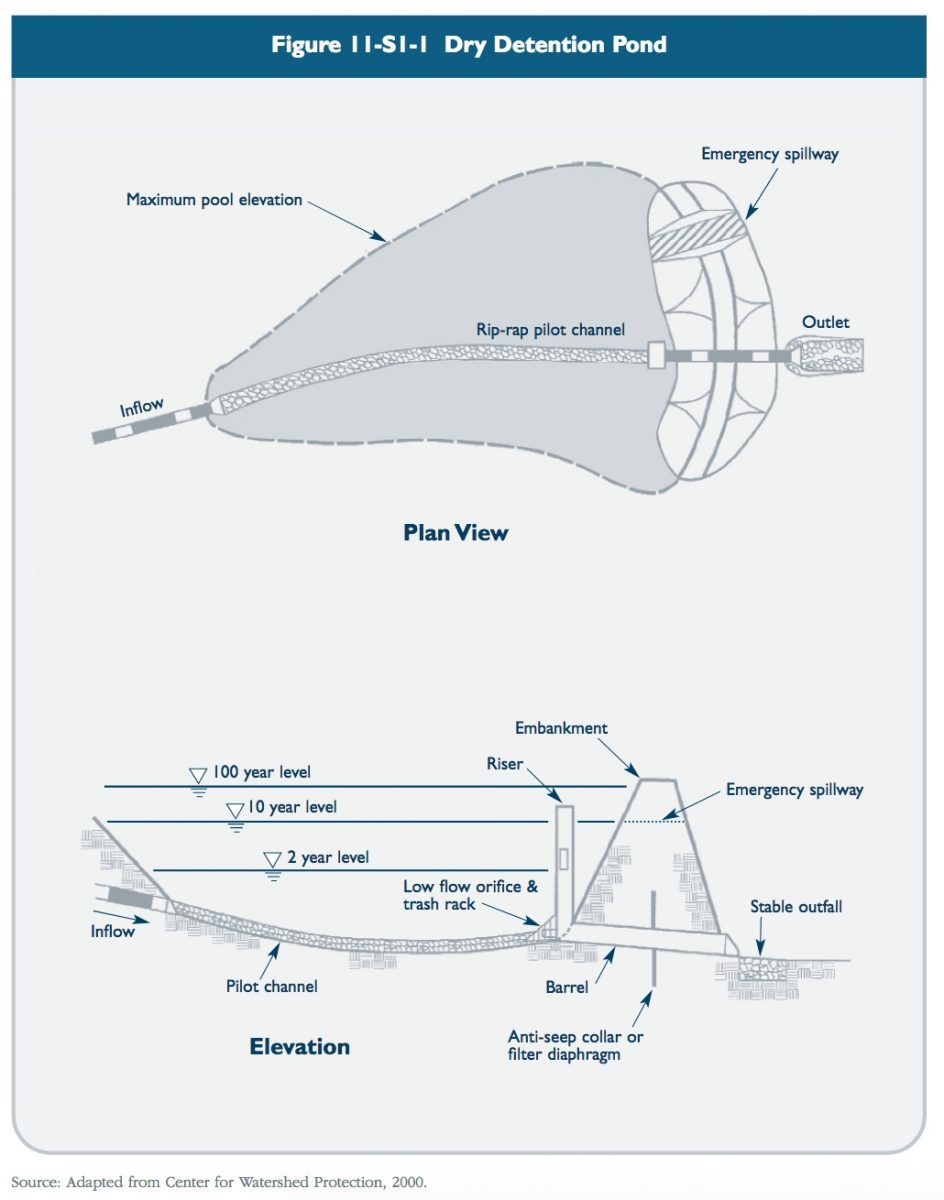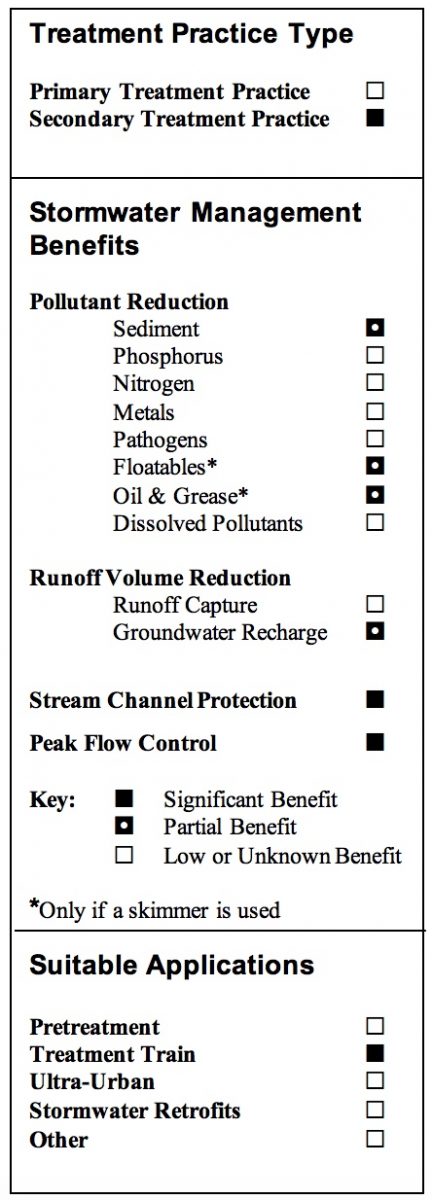Description
Dry detention ponds, also known as “dry ponds” or “detention basins”, are stormwater basins designed to capture, temporarily hold, and gradually release a volume of stormwater runoff to attenuate and delay stormwater runoff peaks. Dry detention ponds provide water quantity control (peak flow control and stream channel protection) as opposed to water quality control. The outlet structure of a dry detention pond is located at the bottom of the pond and sized to limit the maximum flow rate. Dry ponds are designed to completely empty out, typically in less than 24 hours, resulting in limited settling of particulate matter and the potential for re-suspension of sediment by subsequent runoff events. Conventional dry detention ponds differ from extended detention ponds, which provide a minimum 24-hour detention time and enhanced pollutant removal (see Stormwater Ponds section of this chapter). Dry detention ponds are not suitable as infiltration or groundwater recharge measures, and therefore do not reduce runoff volumes. Figure 11-S1-1 shows a schematic of a typical dry detention pond.

Reasons for Limited Use
* Not intended for water quality treatment. Most dry detention ponds have detention times less than 24 hours and lack a permanent pool, providing insufficient settling of particles, and minimal stormwater treatment.
* Susceptible to re-suspension of settled material by subsequent storms.
* Generally require a drainage area of 10 acres or greater to avoid an excessively small outlet structure susceptible to clogging.
Suitable Applications
* Primarily for water quantity control to attenuate peak flows, limit downstream flooding, and provide some degree of channel protection.
* Low-density residential, industrial, and commercial developments with adequate space and low visibility.
* As part of a stormwater treatment train, particularly in combination with other primary or secondary treatment practices that provide pollutant reduction, runoff volume reduction, or groundwater recharge. The size of dry ponds can be reduced substantially by placing them at the end of the treatment train to take advantage of reduced runoff volume resulting from upstream practices that employ infiltration.
* Less frequently used portions of larger or regional dry detention basins can offer recreational, aesthetic, or open space opportunities (e.g., athletic fields, jogging and walking trails, picnic areas).
Design Considerations
The design of detention ponds is dictated by local stormwater quantity control requirements. Local ordinances typically require that post-development peak flows be controlled to pre-development levels for storms ranging from 2-year through 100-year return periods. Control of more frequent events may also be required. The reader should consult the local authority for specific quantity control requirements, as well as the following references for guidance on the design and implementation of conventional dry detention ponds for stormwater quantity control:
* Connecticut Department of Transportation (ConnDOT), Connecticut Department of Transportation Drainage Manual, October 2000.
* Water Environment Federation (WEF) and American Society of Civil Engineers (ASCE), Design and Construction of Urban Stormwater Management Systems (Urban Runoff Quality Management (WEF Manual of Practice FD-20 and ASCE Manual and Report on Engineering Practice No. 77), 1992.
Whenever possible, detention ponds should be designed as extended detention ponds or wet ponds, or used in conjunction with other stormwater treatment practices to provide water quality benefits. Extended detention ponds, which are considered primary stormwater treatment practices (see the Stormwater Ponds section of this chapter), are modified dry detention ponds that incorporate a number of enhancements for improved water quality function. Older, existing dry ponds are also good candidates for stormwater retrofits by incorporating these recommended enhancements (see Chapter Ten), which are summarized below.
* Sediment Forebay: A sediment forebay is an additional storage area near the inlet of the pond that facilitates maintenance and improves pollutant removal by capturing large particles. Sediment forebays can be created by berms or baffles constructed of stone, riprap, gabions or similar materials. The forebay should include a deep permanent pool to minimize the potential for scour and re-suspension (Metropolitan Council, 2001).
* Extended Detention Storage: Extended detention requires sufficient storage capacity to hold stormwater for at least 24 hours to allow solids to settle out. The additional storage volume is usually provided in the lower stages of the pond for treatment of smaller storms associated with the water quality volume, while the upper stages provide storage capacity for large, infrequent storms. Detention ponds should not be designed to hold water for longer than 5 days to reduce the potential for mosquito breeding.
Any stormwater treatment practices that create an embankment, including stormwater detention ponds, are under the jurisdiction of the Dam Safety Section of the Connecticut DEP Inland Water Resources Division (IWRD) and should be constructed, inspected, and maintained in accordance with Connecticut General Statutes Sections 22a-401 through 22a-411, inclusive, and applicable DEP guidance.
* Outlet Wet Pool: A relatively shallow, permanent pool of water at the pond outlet can provide additional pollutant removal by settling finer sediment and reducing re-suspension. The wet pool or micropool can also be planted with wetland species to enhance pollutant removal.
* Pond Configuration: The inlet and outlet of the pond should be positioned to minimize short-circuiting. Baffles and internal grading can be used to lengthen the flow path within the pond. A minimum length-to-width ratio of 2:1 is recommended, and irregularly shaped ponds are desirable due to their more natural and less engineered appearance.
* Low Flow Channels: Low flow channels prevent erosion as runoff first enters a dry pond during the initial period of a storm event, and after a storm, route the final portion to the pond outlet.
References
Center for Watershed Protection (CWP). 2000. The Vermont Stormwater Management Handbook Technical Support Document – Public Review Draft. Prepared For Vermont Agency of Natural Resources.
Connecticut Department of Transportation (DOT). 2000. Connecticut Department of Transportation Drainage Manual.
Metropolitan Council. 2001. Minnesota Urban Small Sites BMP Manual: Stormwater Best Management Practices for Cold Climates. Prepared by Barr Engineering Company. St. Paul, Minnesota.
United States Environmental Protection Agency (EPA). 2002. National Menu of Best Management Practices for Stormwater Phase II.
URL: http://www.epa.gov/npdes/menuofbmps/menu.htm, Last Modified January 24, 2002.
Water Environment Federation (WEF) and American Society of Civil Engineers (ASCE). 1992. Design and Construction of Urban Stormwater Management Systems (Urban Runoff Quality Management (WEF Manual of Practice FD-20 and ASCE Manual and Report on Engineering Practice No. 77).
